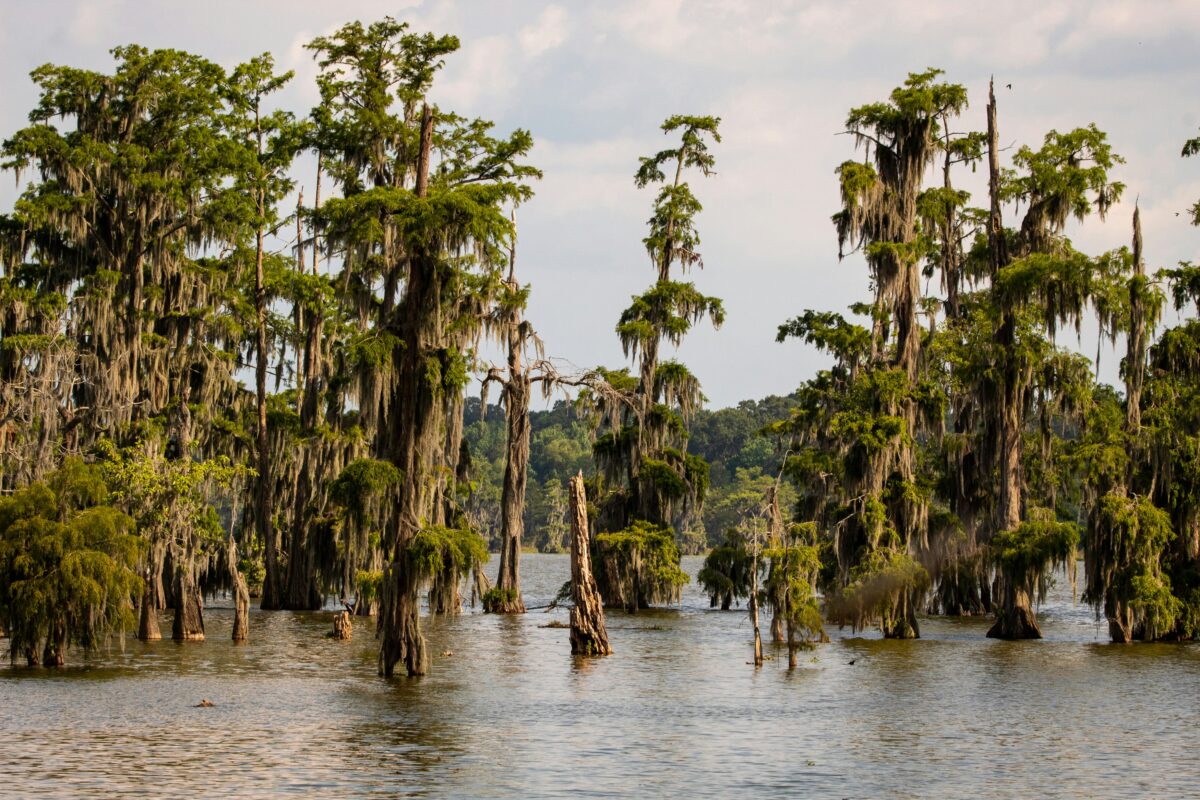The Biloxi-Chitimacha-Choctaw tribal community of Isle de Jean Charles, off the coast of Louisiana, is sinking into the ocean. In the past six decades, the island has lost 98% of its land due to sea level rise and constant coastal erosion, with their five by eleven-mile island shrinking to a mere quarter-mile by two miles. There is one road into the island that floods at least once a week so that no cars can pass. Many factors led to the destruction of the island. Dams and levees were created throughout the Mississippi River, which disrupted the sediment flow that naturally prevented mass erosion. The nearby oil industry created more deltas and channels within the Louisiana wetlands, with the drilling hurting plant structures that previously provided more natural barriers to erosion. Coupled with rising sea levels from global climate change, the island effectively sank. This leaves the people of the isle with a difficult question, to leave their homes and livelihoods behind or to stay in hopes for a different fix.
In 2016, the United States Department of Housing and Urban Development (HUD) granted Louisiana a $48 million federal grant as part of the Obama Administration National Disaster Resilience Competition. The grant’s goal was to aid in the resettlement of Isle de Jean Charles community by relocating the remaining 60 families of the island 40 miles north. The new area would come complete with housing and recreational land to start a new community. However, it has been four slow years for the people of the Isle deJean Charles and the 2022 fund-spending deadline is nearing. Housing at the new location has been slow to build and many members of the community do not want to leave their island.
The community was meant to move to the new location together to preserve community, but many are moving on their own as others refuse to set off from their land and culture. These setbacks have only exacerbated the snail-like-pace the plan is currently moving at. To make matters worse, the sea levels are continuing to rise and the island faced consequences from Hurricane Laura in 2020. The chief of the Isle de Jean Charles Band of Biloxi-Chitimacha-Choctaw tribe Albert Naquin has discussed the plan negatively because of these differing views, claiming it has the potential to be “destroyed.”
The population of the Isle de Jean Charles is overwhelmingly Native American, with their roots explaining why they are not exactly jumping at the idea of resettlement. The village began as part of an escape from the Indian Removal Act and subsequently the Trail of Tears. As a result, there is deep-rooted distrust in government forced relocation. Furthermore, the tribal leaders have accused the government of taking away control over the plan from them. The original plan that was approved by HUD for the grant was spearheaded by Naquin, but the state has since drastically changed and diverted away from the original plan. The media reporting on the case of Isle de Jean Charles has also furthered the sentiment to stay, with many news outlets hailing the grant as a first of its kind for climate “refugees.” The term “refugees” did not ring well throughout the community, as it ignores and erases Native Americans’ identities as the first in the region.
The community and culture created by the island life, especially with the focus on fishing, cannot easily be replaced by everyone packing up their belongings and leaving. Many proclaim that they were born on the island and will die there, pledging to continue living off of the land. With the state attempting to lead the change, they are not listening to the concerns of the community. More and more, it is looking like a result of a scattered relocation instead of the community-preserved proposal by Chief Naquin.
The ongoing COVID-19 pandemic has only worsened the situation for the remaining residents of the island. Many had difficulty filling out the census from the Covid impacts and social distancing expectations, lessening the issuance that the people of the island will be counted and recognized.
2021 shows a grim outlook on the future of Isle de Jean Charles. The population, land, and culture are quickly disappearing on the island. As for what’s next, some are preparing to live by boat—sticking to their heart, and continuing living on the island until there is absolutely nothing left.
Sources:
Adam Aton, E&E News, Aton, A., & E&E News. (2021, February 8). Biden Pushes U.S.—and the World—to Help Climate Migrants. Scientific American. https://www.scientificamerican.com/article/biden-pushes-u-s-and-the-world-to-help-climate-migrants/
AWE News. (2019, February 17). Lora Ann Chaisson of the Houma Tribe Isle de JeanCharles on Relocation [Video]. YouTube. https://www.youtube.com/watch?v=TXVKGx54cx0&ab_channel=AWENEWS
Davenport, C., & Robertson, C. (2016, December 1). Resettling the First American ‘Climate Refugees.’ The New York Times. https://www.nytimes.com/2016/05/03/us/resettling-the-first-american-climate-refugees.html
Dermansky, J. (2020, May 22). Louisiana Breaks Ground on Isle de Jean CharlesResettlement Projec… DeSmog. https://www.desmogblog.com/2020/05/22/isle-de-jean-charles-tribe-louisiana-resettlement-construction
Isle De Jean Charles Resettlement. (n.d.). Isle De Jean Charles. http://isledejeancharles.la.gov/
Jarvie, J. (2019, April 23). On a sinking Louisiana island, many aren’t ready to leave. Los Angeles Times. https://www.latimes.com/nation/la-na-jean-charles-sinking-louisiana-island-20190423-htmlstory.html
Stein, M. I. (2018, January 25). America’s First Climate Change Refugees Try to Save Their Town. Wired. https://www.wired.com/story/how-to-save-a-town-from-rising-waters/

